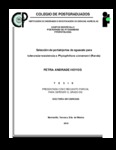| dc.description.abstract | A nivel mundial, el intento por controlar la pudrición de la raíz causada por Phytophthora cinnamomi ha tenido un éxito limitado. La identificación de portainjertos resistentes es una opción para que prospere el cultivo de aguacate en condiciones de presión de inóculo con P. cinnamomi. En plantas de aguacate raza Mexicana de 1 a 2 años y en etapa de plántula, responden a la infección por el oomicete P. cinnamomi. Esta respuesta se debe a la variación genética basada en la supervivencia, y a la implicación de la formación de tilosas y depósito de fenoles como mecanismos de defensa histológica, así como la capacidad totipotencial después de la inoculación con el oomicete. Con el objetivo de seleccionar portainjertos de aguacate tolerantes-resistentes a P. cinnamomi en condiciones de temperaturas controladas se inocularon genotipos de la raza Mexicana: Atlixco, Tepeyanco y Tepetl, y los portainjertos comerciales Thomas y Duke-7 con 250 mL/planta de suspensión micelial de P. cinnamomi (a temperaturas de 17 y 28 °C). El sustrato utilizado para la siembra consistió de una mezcla de peat moss®, suelo agrícola y agrolita® (2:2:1) previamente esterilizado, durante el experimento la humedad en el suelo fue de 90%. Posteriormente, se realizó un estudio de histopatología seleccionando raíces de plantas con marchitez, muertas y asintomáticas para la realización de cortes histopatológicos. Atlixco y Tepeyanco se consideran genotipos con resistencia promisoria por mostrar consistentemente más de 90% de plantas asintomáticas en las dos temperaturas, mientras que los portainjertos Thomas, Duke-7 y Tepetl presentaron resistencia intermedia. En los resultados de histopatología, el contenido de micelio en el xilema de plantas muertas de Duke-7, Thomas y Tepetl mantenidas previamente a 17 °C no mostró diferencias significativas; sin embargo, a 28 °C el contenido de micelio en Duke-7 fue significativo. En plantas con marchitez, la presencia de micelio en Tepetl fue abundante a 17 °C, por lo que se considera susceptible al patógeno. Mientras que a 28 °C los genotipos Tepetl y Atlixco mostraron bajo contenido micelial y por lo tanto se consideran tolerantes-resistentes. En plantas con síntomas de marchitez y asintomáticas, la formación de tilosas y la asociación de compuestos fenólicos contribuyeron a la defensa frente al oomicete. Los genotipos Tepeyanco, Atlixco y Tepetl mostraron resistencia al activar oportunamente sus mecanismos de defensa. En la prueba de resistencia en plántulas se inocularon los genotipos de Atlixco, Tepeyanco, Tepetl, Toliman, segregante de Colín V-33 y Thomas con un aislamiento virulento de P. cinnamomi. Al inocular los genotipos de aguacate a edad temprana (5 cm de altura), es posible detectar resistencia al oomicete en los genotipos de aguacate evaluados, la población de Atlixco es una fuente importante de resistencia al presentar mayor número de nuevos brotes y plántulas asintomáticas aún en etapas avanzadas de crecimiento (15 a 20 cm de altura). Los genotipos Toliman, Tepetl y Thomas en etapa juvenil son considerados susceptibles. Con los resultados obtenidos en la formación de nuevos brotes después de la inoculación los genotipos Atlixco y Tepeyanco se consideran promisorios para resistencia tanto a la marchitez del aguacatero como al cancro causado por P. cinnamomi. _______________ AVOCADO ROOTSTOCK SELECTION FOR TOLERANCE-RESISTANCE TO Phytophthora cinnamomi (Rands). ABSTRACT: Worldwide, the attempt to control root rot caused by Phytophtora cinnamomi has had limited success. Identifying resistant rootstock is an option for avocado crops to grow prosperous under pressure conditions of P. cinnamomi inoculum. Mexican avocado plants, 1 to 2 years of age, in the plantlet stage, respond to infection by P. cinnamomi oomycete. This response is due to the genetic variation based on survival and to the implication of the formation of tyloses and phenol deposits as histological defense mechanisms, as well as the totipotential capacity after inoculation with the oomycete. In order to select the avocado rootstock resistant-tolerant to P. cinnamomi, the following Mexican genotypes: Atlixco, Tepeyanco, and Tepetl along with the commercial rootstock Thomas and Duke-7 were inoculated with 250 Ml/plant with a mycelial suspension of P. cinnamomi at (17 and 28 ºC). The substrate used for planting was a mixture of peat moss™, agricultural soil, and agrolite™ (2:2:1), all previously sterilized. During the experiment, soil humidity was 90%. Later, a histopathological study was done by selecting roots from wilting, dead, and asymptomatic plants for histopathological cuts. Atlixco and Tepeyanco are genotypes considered with promising resistance since they consistently showed more than 90% asymptomatic plants at both temperatures. On the other hand, Thomas, Duke-7, and Tepetl rootstock showed an intermediate resistance. In the histopathological results, the mycelia content in the plant xylem of dead Duke-7, Thomas, and Tepetl plants, previously kept at 17 ºC showed no significant differences; however, at 28 ºC, the mycelia content in Duke-7 was significant. In wilting plants, the presence of mycelia in Tepetl was abundant at 17 ºC, and therefore it is considered susceptible to the pathogen. At 28 ºC, the Tepetl and Atlixco genotypes showed a low mycelia content, and therefore are considered as resistant-tolerant. In wilting and asymptomatic plants, tylose formation and the association of phenol compounds contributed to the defense against the oomycete. The Tepeyanco, Atlixco, and Tepetl genotypes showed resistance by opportunely activating their defense mechanisms. In the resistance test with plantlets, the Atlixco, Tepeyanco, Tepetl, Toliman, Colin V-33 segregate and Thomas genotypes were inoculated with a virulent isolation of P. cinnamomi. When the avocado genotypes are inoculated at an early age (5 cm height), it is possible to detect resistance to the oomycete in the evaluated avocado genotypes. The Atlixco population is an important source of resistance given that it has the greatest number of new asymptomatic shoots and plantlets, even in advanced growth stages (15 to 20 cm height). The Toliman, Tepetl and Thomas genotypes at the juvenile stage are considered as susceptible. With the results obtained on the formation of new shoots after inoculation, the Atlixco and Tepeyanco genotypes are considered as promising with regard to resistance both to wilting of the orchard and the chancre caused by P. cinnamomi. | en_US |


